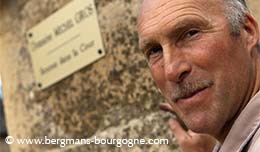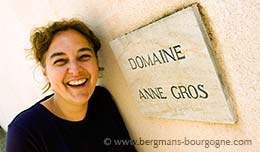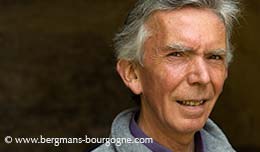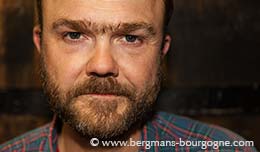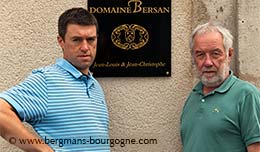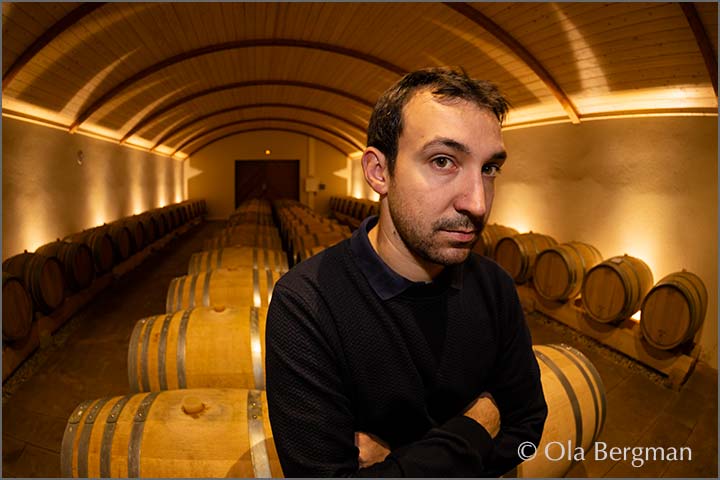
ince Damien Martin arrived at the family domaine in 2010 Domaine de la Denante has doubled both in terms of surface area and number of cuvées. Yields have been reduced and focus is now on lieux-dits rather than large cuvées.
– Today there is more focus on the fruit in the wines, says Damien Martin. There is also a better tension, with a nice minerality.
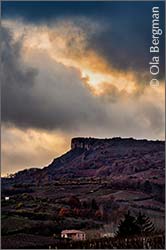 The place is Davayé, in the heart of the Mâconnais. This is white wine country, not far from the iconic sites of the Rock of Solutré and the Rock of Vergisson.
The place is Davayé, in the heart of the Mâconnais. This is white wine country, not far from the iconic sites of the Rock of Solutré and the Rock of Vergisson.
– My father created the domaine in 1975, continues Damien Martin. He started out with two and a half hectares. By 2010 he had managed to grow the domaine to cover ten hectares. Since my arrival we have been lucky to add another ten hectares. There also remain another five hectares to be planted.
The winemaking tradition of the family was started already by Damien Martin’s grandfather. He created Domaine de la Croix Senaillet, which is run by Damien’s uncles today.
Domaine de la Denante takes its name from the stream, La Denante, which runs through Davayé. About 80 per cent of the domaine is white. The remaining vineyards are planted with gamay and pinot noir for the Macon-Davayé and the Bourgogne rouge.
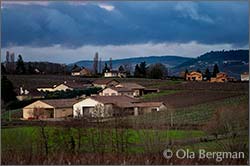 – We have been putting a lot of thought into this, how we can improve vinification and which parcels can be turned into separate cuvées. My father only made one Mâcon, one Saint-Véran, one Pouilly-Fuissé and one red.
– We have been putting a lot of thought into this, how we can improve vinification and which parcels can be turned into separate cuvées. My father only made one Mâcon, one Saint-Véran, one Pouilly-Fuissé and one red.
The white Macon-Davayé comes from a single parcel just 150 metres from the winery. The vines are young, planted in 2008, and the soil is deep, mainly clay.
– It’s an easy drinking wine with lots of fruit, says Damien Martin. It’s round, very typical chardonnay. It even has a bit of fat and richness.
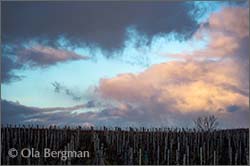 – The vinification is quite different for the different cuvées. The Macon-Davayé is 100 per cent stainless steel. I leave a lot of sediment, because I want to preserve the fruit.
– The vinification is quite different for the different cuvées. The Macon-Davayé is 100 per cent stainless steel. I leave a lot of sediment, because I want to preserve the fruit.
15 kilometres north of Davayé is Verzé. Here you’ll find the four hectares of vines for the Mâcon-Verzé of Domaine de la Denante. The soil is different, more flint.
– The soil in Verzé produces a wine with more tension, explains Damien Martin. This wine is harder, but still with a nice richness. It’s a wine that needs food. There is less fruit, but it’s longer on the palate than the Macon-Davayé.
 – The incline is 13 degrees and there are both old and young vines. The oldest ones were planted in 1944. The others in 1987, 2004, 2014 and 2016. Up until now it has been fifty-fifty old and new vines, but as the youngest vineyards come into production the proportions are changing.
– The incline is 13 degrees and there are both old and young vines. The oldest ones were planted in 1944. The others in 1987, 2004, 2014 and 2016. Up until now it has been fifty-fifty old and new vines, but as the youngest vineyards come into production the proportions are changing.
In the Mâconnais the appellations are not as geographically simple as in the Côte d’Or where one appellation/one village usually is the case. Saint-Véran stretches over seven villages, with Davayé being one of them. At Domaine de la Denante this is the main appellation, with 7.80 hectares of vineyards. What used to be one single cuvée is now split into three – one straight Saint-Véran and two single vineyard cuvées‚ Les Maillettes and Les Cras.
– The straight Saint-Véran is a blend of several parcels, says Damien Martin. But they are all vinified differently. Instead of putting everything in one tank I want to see how each part develops. It gives me more freedom. It allows me to experiment more with the final blend. We do three bottlings of this cuvée, so with the different parcels I’m able to do some tweaking. You have to be very familiar with the different parcels. But when you know which one brings the fruit, which one brings the minerality etc it helps you a lot when blending.
 All the Saint-Véran vineyards of Domaine de la Denante are located around the Rock of Vergisson. Which lieu-dits which make up the straight Saint-Véran differs a bit from year to year, but the bulk is usually from Châtaigniers le Haut, Au Mont and Les Fournaises.
All the Saint-Véran vineyards of Domaine de la Denante are located around the Rock of Vergisson. Which lieu-dits which make up the straight Saint-Véran differs a bit from year to year, but the bulk is usually from Châtaigniers le Haut, Au Mont and Les Fournaises.
In 2014 Damien Martin singled out Les Maillettes. It is a Saint-Véran lieu-dit right next to the winery in Davayé. It is a plateau, allowing the vines to soak up the sun from morning until late evening.
– It’s completely different from the straight Saint-Véran, says Damien Martin. In character it’s more like a wine from further up north in Burgundy. It’s richer and fatter. This parcel always produces very golden, concentrated, often millerandé grapes. For this wine I use 50 per cent barrels and 50 per cent tank. Bottling is later, in July instead of in May.
 The most recent addition to the portfolio – the Saint-Véran, Les Cras – goes even further. The first vintage was 2017 and after ten months of élevage in barrel this wine sees another ten months in tank.
The most recent addition to the portfolio – the Saint-Véran, Les Cras – goes even further. The first vintage was 2017 and after ten months of élevage in barrel this wine sees another ten months in tank.
– It’s a cuvée I created for my son, says Damien Martin. Since I hadn’t tried a long élevage like this before I thought it would be interesting to try 20 months. If more is needed I’ll add a few more months. It’s very aromatic on the nose, but it’s still a Saint-Véran, so you have the freshness as well.
The vines in Les Cras are 60 years old. It is white limestone, poor soil. The yield is low. 50 hl/ha instead of 62 hl/ha.
The Pouilly-Fuissé of the domaine is not quite as old. Planted in 1976 this parcel recently had what could be called a second life. It does not say on the labels, but it is in Vers Chânes in Fuissé. It’s at the top of the slope and previously the grapes often proved difficult to ripen.
– It was just below the forest, says Damien Martin. In 2014 they removed the trees and as a result the wine turned into something completely different. Now it’s rich, with notes of candied fruit and vanilla. Compared with Les Maillettes it’s more closed on the nose, but more expressive on the palate.
© 2019 Ola Bergman










